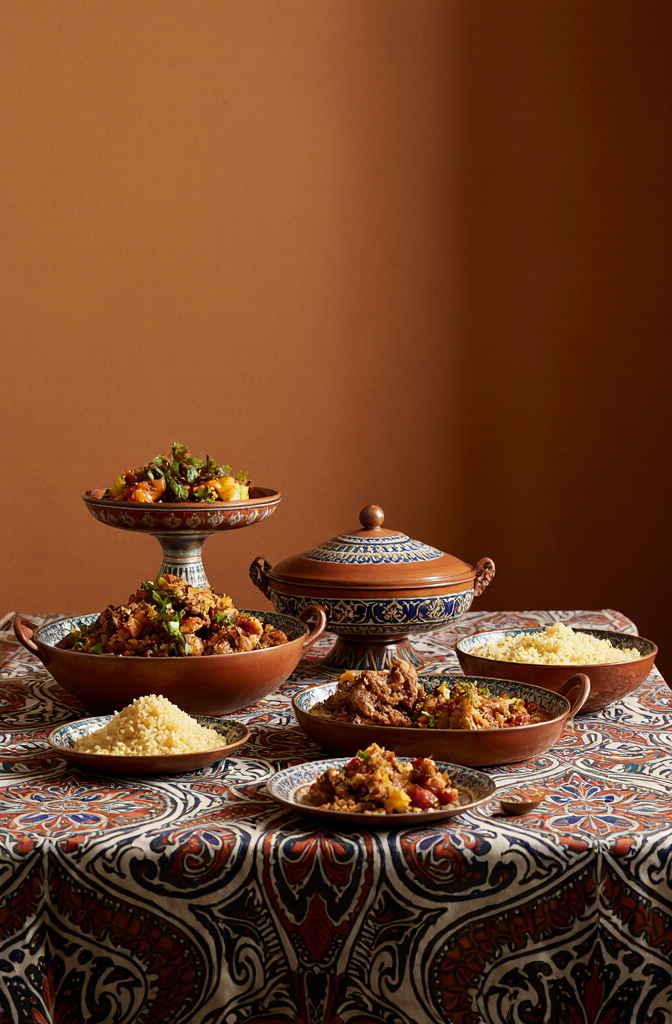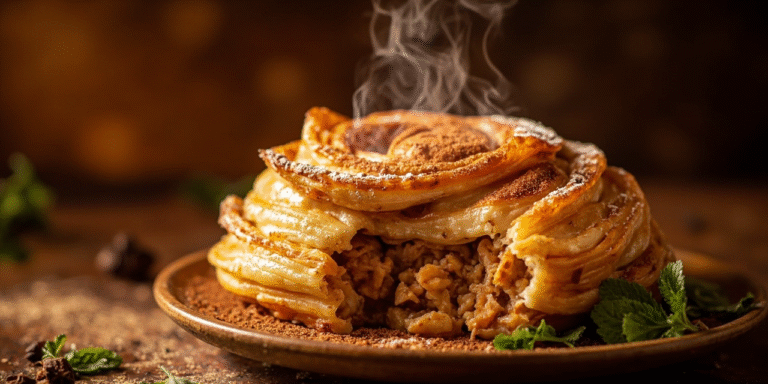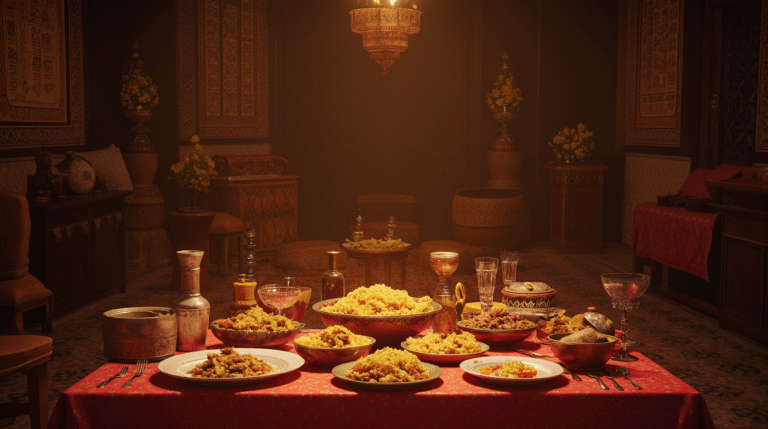Traditional Moroccan Recipes: 7 Must-Try Dishes for Beginners
Have you ever thought that cooking exotic, flavorful meals from faraway places is only for professional chefs? What if you could bring the warm spices, fragrant herbs, and comforting textures of Morocco into your kitchen—without needing a passport or years of experience?
Good news: you absolutely can! Traditional Moroccan recipes are full of bold flavors, healthy ingredients, and simple techniques that are perfect for beginners. In this guide, we’ll walk you through seven must-try dishes that are easy to make, deeply satisfying, and sure to impress your family (or yourself!).
Why These Traditional Moroccan Recipes Are Perfect for Beginners
Moroccan food is known for its balance of sweet and savory, its use of aromatic spices like cumin, cinnamon, and saffron, and its slow-cooked, tender dishes. But don’t worry—you don’t need a tagine pot or hours of free time to enjoy it!
**Time required:** Most of these recipes take 30–60 minutes.
**Difficulty level:** Easy to moderate—great for weeknights or weekend cooking adventures.
**What makes them special:** They’re packed with flavor, use pantry-friendly ingredients, and often get even better the next day!
Essential Ingredients in Traditional Moroccan Recipes
Before we dive into the dishes, let’s talk about the building blocks of Moroccan cooking. These ingredients show up again and again—and for good reason!
– **Cumin**: Earthy and warm, it’s the backbone of many spice blends.
– **Cinnamon**: Adds sweetness to savory dishes (yes, really!).
– **Paprika & Cayenne**: For color and gentle heat.
– **Preserved lemons**: Tangy and salty—key in tagines. (No preserved lemons? Use lemon zest + a pinch of salt.)
– **Olives**: Green olives add briny depth to stews.
– **Fresh herbs**: Parsley and cilantro are used generously.
– **Olive oil**: For cooking and finishing dishes.
– **Chickpeas**: A protein-rich staple in soups and salads.
– **Couscous**: Quick-cooking and fluffy—it’s Morocco’s favorite grain.
**Substitutions:**
– No saffron? A pinch of turmeric adds color (but not the same flavor).
– Can’t find harissa? Mix tomato paste with chili powder and garlic.
– Vegetarian? Swap meat for extra chickpeas, lentils, or roasted veggies.
The 7 Must-Try Traditional Moroccan Recipes for Beginners
1. **Easy Chicken Tagine with Olives and Lemons**
A classic one-pot wonder! Tender chicken simmers with green olives and preserved lemons in a spiced broth.
**Tip:** Brown the chicken first for extra flavor. Serve with crusty bread or couscous.
2. **Vegetable Couscous**
Fluffy steamed couscous topped with carrots, zucchini, turnips, and chickpeas in a light broth.
**Tip:** Fluff couscous with a fork and drizzle with olive oil before serving.
3. **Moroccan Lentil Soup (Harira)**
Hearty, spiced, and perfect for cold days. Made with lentils, tomatoes, and fresh herbs.
**Tip:** Add a splash of lemon juice at the end for brightness.
4. **Spiced Moroccan Meatballs (Kefta)**
Juicy beef or lamb meatballs cooked in a rich tomato sauce with eggs cracked on top.
**Tip:** Don’t overmix the meat—keep it tender!
5. **Zaalouk (Eggplant & Tomato Dip)**
A smoky, garlicky cooked salad served with bread. Great as a side or appetizer.
**Tip:** Roast the eggplant whole until soft, then peel and mash.
6. **Moroccan Carrot Salad**
Sweet, tangy, and ready in 10 minutes! Grated carrots with lemon, cumin, and parsley.
**Tip:** Let it sit for 15 minutes before serving so flavors blend.
7. **Mint Tea (Atay)**
Not a dish, but essential! Sweet green tea with fresh mint—Morocco’s national drink.
**Tip:** Pour from a height to create foam—it’s part of the tradition!
Step-by-Step: How to Make Chicken Tagine (Your First Traditional Moroccan Recipe!)
Let’s walk through one of the most beloved dishes: **Chicken Tagine with Olives and Lemons**.
**Ingredients:**
– 4 chicken thighs (bone-in, skin-on for best flavor)
– 2 tbsp olive oil
– 1 onion, chopped
– 2 garlic cloves, minced
– 1 tsp ground cumin
– 1 tsp ground ginger
– ½ tsp cinnamon
– 1 preserved lemon, chopped (or zest of 1 lemon + ½ tsp salt)
– ½ cup green olives
– 1 cup chicken broth
– Fresh cilantro and parsley
**Instructions:**
1. **Brown the chicken**: Heat oil in a deep skillet or Dutch oven. Sear chicken until golden (5–6 minutes per side). Remove and set aside.
2. **Sauté aromatics**: In the same pot, cook onion until soft (4 minutes). Add garlic and spices; stir 1 minute until fragrant.
3. **Simmer**: Return chicken to the pot. Add broth, preserved lemon, and olives. Cover and simmer on low for 30–40 minutes until chicken is tender.
4. **Finish**: Stir in fresh herbs. Taste and adjust salt if needed.
**Pro tip:** If the sauce is too thin, remove the lid and simmer 5–10 minutes to thicken.
Assembly & Presentation Tips
Moroccan meals are often served family-style, with dishes placed in the center of the table. Here’s how to plate like a pro:
– **Use a large shallow bowl** for tagines—show off the olives and lemons!
– **Fluff couscous** and mound it on a platter, then spoon vegetables around it.
– **Garnish generously**: Fresh herbs, a drizzle of olive oil, or a sprinkle of paprika add color.
– **Serve mint tea in clear glasses**—it looks beautiful and feels special.
Storage & Make-Ahead Tips
One of the best things about Traditional Moroccan Recipes? They taste even better the next day!
– **Refrigerate**: Store cooked dishes in airtight containers for up to 4 days.
– **Freeze**: Tagines and soups freeze well for up to 3 months. Thaw overnight in the fridge.
– **Reheat gently**: Warm on the stove over low heat. Add a splash of water or broth if dry.
– **Prep ahead**: Chop onions, garlic, and herbs the night before. Cook couscous in advance and re-fluff with hot water.
Recipe Variations to Try Make these dishes your own!
– **Go vegetarian**: Swap chicken for chickpeas, sweet potatoes, or mushrooms in tagines.
– **Add heat**: Stir in harissa paste or a pinch of cayenne for spice lovers.
– **Make it gluten-free**: Use quinoa or rice instead of couscous.
– **Dairy-free?** All these recipes are naturally dairy-free—Moroccan food rarely uses cheese or cream!
– **Fruit twist**: Add dried apricots or prunes to tagines for a sweet-savory combo.
Conclusion: Your Moroccan Kitchen Adventure Awaits!
You don’t need to be a chef to enjoy the magic of Traditional Moroccan Recipes. With warm spices, simple techniques, and big flavors, these seven dishes are your gateway to a whole new world of cooking. Whether you’re feeding your family or treating yourself, each bite brings comfort, culture, and joy.
So grab your spices, heat up that pot, and give one (or all!) of these recipes a try. Your taste buds—and your dinner table—will thank you.
FAQs: Your Questions, Answered
**Q: Are Traditional Moroccan Recipes healthy?**
A: Yes! They’re rich in vegetables, legumes, lean proteins, and heart-healthy olive oil. Spices like cumin and turmeric also have anti-inflammatory benefits.
**Q: How long do these dishes take to make?**
A: Most take 30–60 minutes. Soups and salads are even quicker—under 30 minutes!
**Q: Can I make these without a tagine pot?**
A: Absolutely! A Dutch oven, deep skillet, or even a slow cooker works perfectly.
**Q: Are these recipes kid-friendly?**
A: Many are! Try mild versions of carrot salad or vegetable couscous. Kids often love the sweet-savory flavors.
**Q: How do I store leftovers?**
A: Keep in sealed containers in the fridge for up to 4 days. Reheat on the stove with a little water to refresh flavors.
**Q: What’s the secret to authentic flavor?**
A: Toast your spices lightly before using, and don’t skip the fresh herbs—they make all the difference!
Now you’re ready to explore the delicious world of Traditional Moroccan Recipes—one simple, satisfying dish at a time. Happy cooking!




